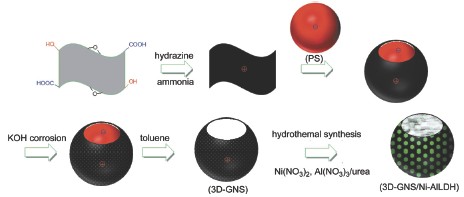| [1] Liu, C.; Li, F.; Ma, L. P.; Cheng, H. M. Adv. Mater. 2010, 22, E28. [2] Niu, Y. L.; Jin, X.; Zheng, J.; Li, Z. J.; Gu, Z. G.; Yan, T.; Fang, Y. J. Chin. J. Inorg. Chem. 2012, 28, 1879. (牛玉莲, 金鑫, 郑佳, 李在均, 顾志国, 严涛, 方银军, 无机化学学报, 2012, 28, 1879.) [3] Chen, Y. F.; Li, Y. Y.; Deng, M. G. Chin. J. Electron. Components Mater. 2008, 27, 6. (陈英放, 李媛媛, 邓梅根, 电子元件与材料, 2008, 27, 6.) [4] Frackowiak, E.; Béguin, F. Carbon 2001, 39, 937. [5] Pröbstle, H.; Schmitt, C.; Fricke, J. J. Power Sources 2002, 105, 189. [6] Park, J. H.; Ko, J. M.; Park, O. O. J. Electrochem. Soc. 2003, 150, A864. [7] Kim, T. Y.; Lee, H. W.; Stoller, M.; Dreyer, D. R.; Bielawski, C. W.; Ruoff, R. S.; Suh, K. S. ACS Nano 2010, 5, 436. [8] Susanti, D.; Tsai, D. S.; Huang, Y. S.; Korotcov, A.; Chung, W. H. J. Phys. Chem. C 2007, 111, 9530. [9] Subramanian, V.; Zhu, H. W.; Wei, B. Q. J. Power Sources 2006, 159, 361. [10] Xu, J.; Gao, L.; Cao, J. Y.; Wang, W. C.; Chen, Z. D. Electrochim. Acta 2010, 56, 732. [11] Zhao, B.; Ke, X. K.; Bao, J. H.; Wang, C. L.; Dong, L.; Chen, Y. W.; Chen, H. L. J. Phys. Chem. C 2009, 113, 14440. [12] Wang, H. L.; Casalongue, H. S.; Liang, Y. Y.; Dai, H. J. J. Am. Chem. Soc. 2010, 132, 7472. [13] Wang, K.; Huang, J. Y.; Wei, Z. X. J. Phys. Chem. C 2010, 114, 8062. [14] Vivekchand, S.; Rout, C. S.; Subrahmanyam, K.; Govindaraj, A.; Rao, C. N. R. J. Chem. Sci. 2008, 120, 9. [15] Stoller, M. D.; Park, S.; Zhu, Y.; An, J.; Ruoff, R. S. Nano Lett. 2008, 8, 3498. [16] Wang, Y.; Shi, Z. Q.; Huang, Y.; Ma, Y. F.; Wang, C. Y.; Chen, M. M.; Chen, Y. S. J. Phys. Chem. C 2009, 113, 13103. [17] Williams, G. R.; O'Hare, D. J. Mater. Chem. 2006, 16, 3065. [18] Wang, J.; Song, Y. C.; Li, Z. S.; Liu, Q.; Zhou, J, D.; Jing, X. Y.; Zhang, M, L.; Jiang, Z. H. Energy Fuels 2010, 24, 6463. [19] Wang, L.; Wang, D.; Dong, X. Y.; Zhang, Z. J.; Pei, X. F.; Chen, X. J., Chen, B.; Jin, J. Chem. Commun. 2011, 47, 3556. [20] Hu, Z. A.; Xie, Y. L.; Wang, Y. X.; Wu, H. Y.; Yang, Y. Y.; Zhang, Z. Y. Electrochim. Acta 2009, 54, 2737. [21] Ma, W. S.; Zhou, J. W.; Cheng, S. X. J. Chem. Eng. Chin. Univ. 2010, 24, 719. (马文石, 周俊文, 程顺喜, 高校化学工程学报, 2010, 24, 719.) [22] Su, P.; Guo, H. L.; Peng, S.; Ning, S. K. Acta Phys.-Chim. Sin. 2012, 28, 2745. (苏鹏, 郭慧林, 彭三, 宁生科, 物理化学学报, 2012, 28, 2745.) [23] Hu, H. T. M.S. Thesis, Hubei University, Wuhan, 2010. (胡华亭, 硕士论文, 湖北大学, 武汉, 2010.) [24] Yang, Y. H.; Sun, H. J.; Peng, T. J. Chin. J. Inorg. Chem. 2010, 26, 2083. (杨永辉, 孙红娟, 彭同江, 无机化学学报, 2010, 26, 2083.) [25] Gao, Z.; Wang, J.; Li, Z. S.; Yang, W. L.; Wang, B.; Hou, M. J.; He, Y.; Liu, Q.; Mann, T.; Yang, P. P.; Zhang, M. L.; Liu, L. H. Chem. Mater. 2011, 23, 3509. [26] Su, L. H.; Zhang, X. G. J. Power Sources 2007, 172, 999. [27] Lu, Z. Y.; Yang, Q.; Zhu, W.; Chang, Z.; Liu, J. F.; Sun, X. M.; Evans, D. G.; Duan, X. Nano Res. 2012, 5, 369. [28] Zheng, M. B.; Cao, J.; Liao, S. T.; Liu, J. S.; Chen, H. Q.; Zhao, Y.; Dai, W. J.; Ji, G. B.; Cao, J. M.; Tao, J. J. Phys. Chem. C 2009, 113, 3887. [29] Niu, Y. L.; Xiao, X. Q.; Gu, Z. G.; Li, Z. J. Chin. J. Inorg. Chem. 2012, 28, 751. (牛玉莲, 肖雪清, 顾志国, 李在均, 无机化学学报, 2012, 28, 751.) |
